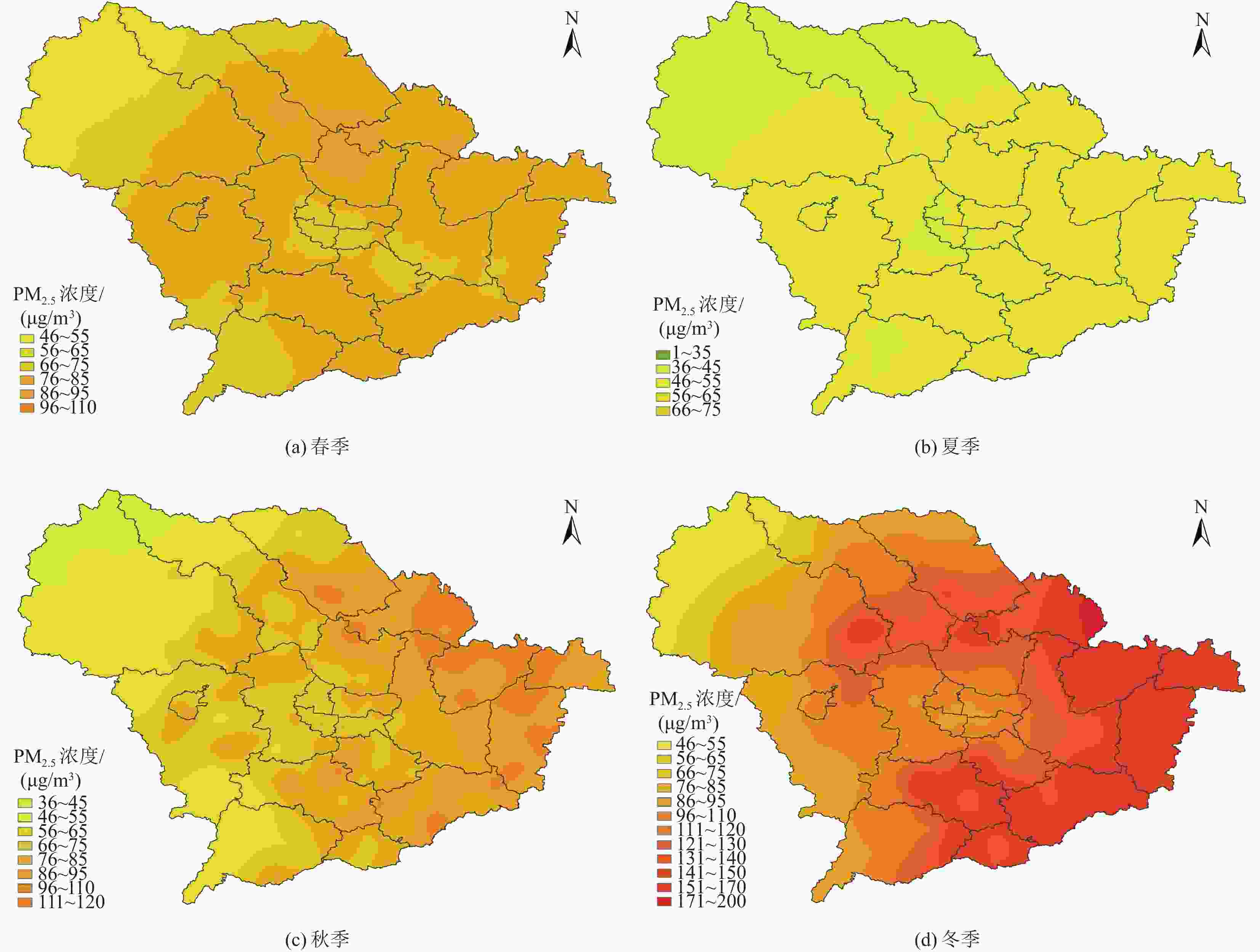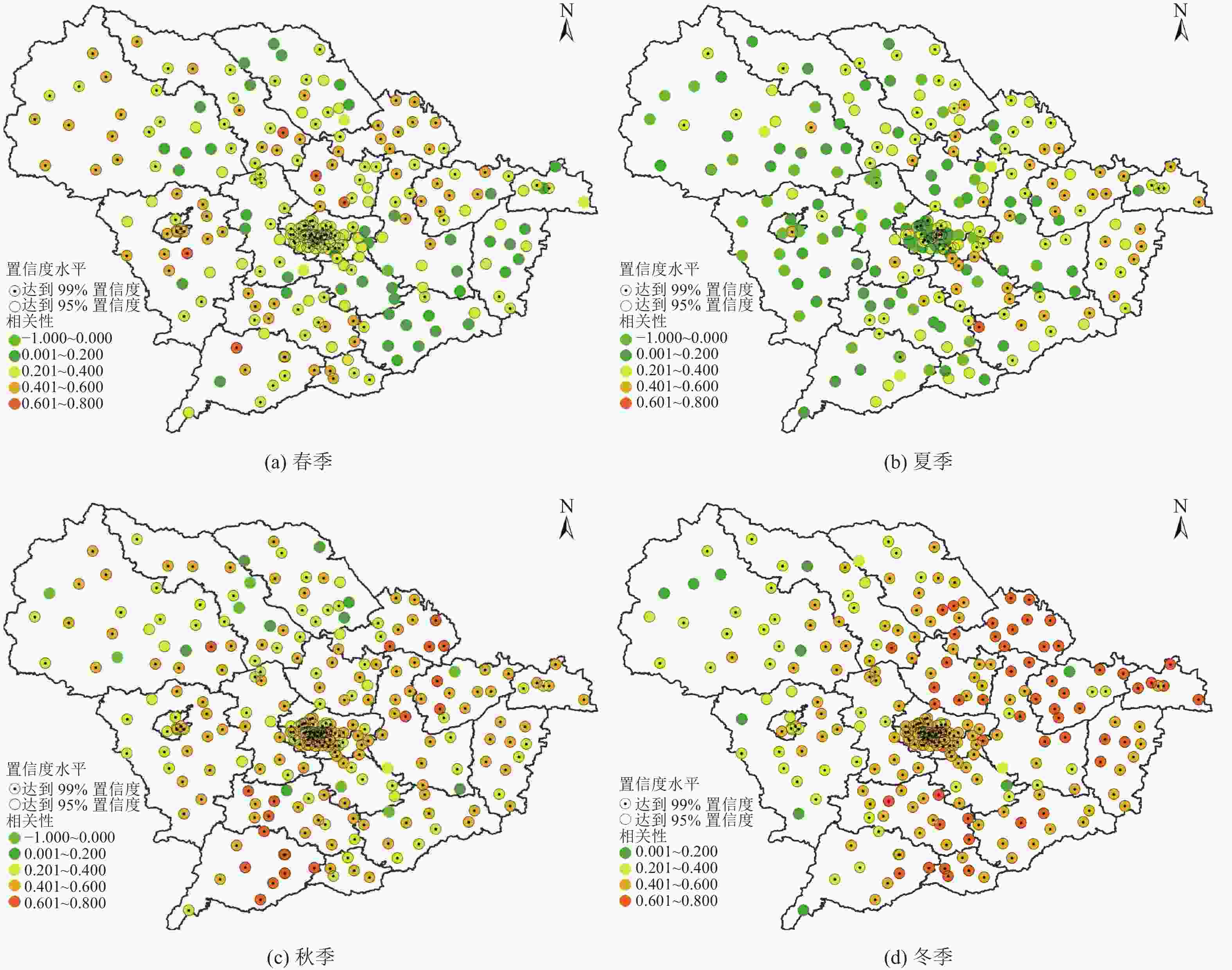Research on the temporal and spatial distribution of PM2.5 at the township scales: a case study in Shijiazhuang City
-
摘要:
利用261个乡镇环境空气自动监测站监测数据,结合GIS空间分析技术,在乡镇尺度下分析2018年石家庄市PM2.5时空分布特征,并探讨PM2.5与气态前体物SO2、NO2的相关性特征。结果表明:2018年261个乡镇PM2.5年均浓度为41~112 μg/m3,均超过GB 3095—2012《环境空气质量标准》二级标准。PM2.5浓度总体呈西北部地势较高的山区低于东南部的平原地区、主城区低于周边县(市、区)的分布态势;石家庄市PM2.5浓度冬季最高,夏季最低,1—3月、11—12月为PM2.5污染较重的月份,4—9月为污染较轻的月份,其中8月为PM2.5月均浓度最小的月份;观测期间,PM2.5浓度与SO2、NO2浓度均呈显著正相关,相关性在夏季最低,冬季最显著,且污染程度越重的区域相关性越显著。
Abstract:The spatial and temporal distribution characteristics of PM2.5 were analyzed at the township scales with the monitoring data from 261 automatic air quality monitoring stations of Shijiazhuang City in 2018, using the spatial analysis method of geographic information systems (GIS). The correlation characteristics between PM2.5 and its precursors (SO2, NO2) were also discussed. The results showed that the annual concentration of PM2.5 in 261 townships was 41-112 μg/m3 in 2018, which exceeded the secondary standard limit of Ambient Air Quality Standards (GB 3095-2012). The concentration of PM2.5 was generally lower in the mountainous area with higher terrain in the northwest than that in the plain area in the southeast, and it was lower in the main urban area than that in the surrounding counties (cities and districts). In respect of seasonal variation, the average concentrations of PM2.5 in Shijiazhuang City was the highest in winter and lowest in summer. Monthly average concentrations of PM2.5 showed that it was from January to March and from November to December that the data of PM2.5 were higher than those of the rest months of the year, August was the month that with the lowest monthly average concentration. The concentration of PM2.5 was significantly positively correlated with the concentration of both SO2 and NO2 in the observation period. The degree of the correlation was the weakest in summer and the strongest in winter, and the more serious the pollution was, the more significant the degree of regional correlation was.
-
Key words:
- PM2.5 /
- SO2 /
- NO2 /
- temporal and spatial distribution /
- township scales /
- Shijiazhuang City
-
表 1 PM2.5浓度月度分布情况
Table 1. Monthly distribution of PM2.5 concentrations
μg/m3 项目 1月 2月 3月 4月 5月 6月 7月 8月 9月 10月 11月 12月 采暖期 非采暖期 平均值 128 113 106 66 60 49 50 43 45 66 120 115 124 59 最大值 200 176 137 90 91 85 86 79 85 103 185 217 189 85 最小值 34 50 60 38 38 24 18 18 17 31 64 45 55 34 最大浓度差 166 126 77 52 53 61 68 61 68 72 121 172 134 51 -
[1] 王胜杰, 解淑艳, 王军霞, 等.2016—2019年汾渭平原城市空气质量状况分析[J]. 中国环境监测,2020,36(6):57-65.WANG S J, XIE S Y, WANG J X, et al. Analysis of air quality in Fenwei Plain from 2016 to 2019[J]. Environmental Monitoring in China,2020,36(6):57-65. [2] 毛敏娟, 胡德云.杭州G20峰会空气污染控制状况评估[J]. 环境科学研究,2017,30(12):1822-1831.MAO M J, HU D Y. Evaluation of the air pollution control over Zhejiang Province during the G20 Summit in Hangzhou[J]. Research of Environmental Sciences,2017,30(12):1822-1831. [3] COHEN A J, BRAUER M, BURNETT R, et al. Estimates and 25-year trends of the global burden of disease attributable to ambient air pollution: an analysis of data from the Global Burden of Diseases Study 2015[J]. The Lancet,2017,389:1907-1918. doi: 10.1016/S0140-6736(17)30505-6 [4] 昌晶亮, 余洪, 罗伟伟.珠三角地区PM2.5浓度空间自相关分析[J]. 生态与农村环境学报,2015,31(6):853-858. doi: 10.11934/j.issn.1673-4831.2015.06.009CHANG J L, YU H, LUO W W. Spatial autocorrelation analysis of PM2.5 concentration in the Pearl River Delta[J]. Journal of Ecology and Rural Environment,2015,31(6):853-858. doi: 10.11934/j.issn.1673-4831.2015.06.009 [5] KAN H D, CHEN R J, TONG S L. Ambient air pollution, climate change, and population health in China[J]. Environment International,2012,42:10-19. doi: 10.1016/j.envint.2011.03.003 [6] WEICHENTHAL S, VILLENEUVE P J, BURNETT R T, et al. Long-term exposure to fine particulate matter: association with nonaccidental and cardiovascular mortality in the agricultural health study cohort[J]. Environmental Health Perspectives,2014,122(6):609-615. doi: 10.1289/ehp.1307277 [7] 王露, 毕晓辉, 刘保双, 等.菏泽市PM2.5源方向解析研究[J]. 环境科学研究,2017,30(12):1849-1858.WANG L, BI X H, LIU B S, et al. Source directional apportionment of PM2.5 in Heze City[J]. Research of Environmental Sciences,2017,30(12):1849-1858. [8] 李惠娟, 周德群, 魏永杰.2015—2018年我国PM2.5健康损害价值的动态评估[J]. 环境科学,2020,41(12):5225-5235.LI H J, ZHOU D Q, WEI Y J. Dynamic assessment of PM2.5 health damage value in China from 2015 to 2018[J]. Environmental Science,2020,41(12):5225-5235. [9] 生态环境部. 环境空气质量标准: GB 3095—2012[S]. 北京: 中国环境科学出版社, 2012. [10] 景悦, 孙艳玲, 徐昊, 等.基于混合效应模型的京津冀地区PM2.5日浓度估算[J]. 中国环境科学,2018,38(8):2890-2897. doi: 10.3969/j.issn.1000-6923.2018.08.012JING Y, SUN Y L, XU H, et al. Daily estimation of PM2.5 concentrations based on mixed effects model in Beijing-Tianjin-Heibei Region[J]. China Environmental Science,2018,38(8):2890-2897. doi: 10.3969/j.issn.1000-6923.2018.08.012 [11] 梅杨, 张文婷, 杨勇, 等.基于时空指示克里格的PM2.5不确定性分布[J]. 中国环境科学,2018,38(1):35-43. doi: 10.3969/j.issn.1000-6923.2018.01.004MEI Y, ZHANG W T, YANG Y, et al. Uncertainty assessment of PM2.5 probability mapping by using spatio-temporal indicator Kriging[J]. China Environmental Science,2018,38(1):35-43. doi: 10.3969/j.issn.1000-6923.2018.01.004 [12] 李珊珊, 程念亮, 徐峻, 等.2014年京津冀地区PM2.5浓度时空分布及来源模拟[J]. 中国环境科学,2015,35(10):2908-2916. doi: 10.3969/j.issn.1000-6923.2015.10.004LI S S, CHENG N L, XU J, et al. Spatial and temporal distrubions and source simulation of PM2.5 in Beijing-Tianjin-Hebei Region in 2014[J]. China Environmental Science,2015,35(10):2908-2916. doi: 10.3969/j.issn.1000-6923.2015.10.004 [13] 王振波, 方创琳, 许光, 等.2014年中国城市PM2.5浓度的时空变化规律[J]. 地理学报,2015,70(11):1720-1734. doi: 10.11821/dlxb201511003WANG Z B, FANG C L, XU G, et al. Spatial-temporal characteristics of the PM2.5 in China in 2014[J]. Acta Geographica Sinica,2015,70(11):1720-1734. doi: 10.11821/dlxb201511003 [14] 张娟, 王炜, 赵颖.北京市延庆区PM2.5中主要水溶性无机离子特征及来源解析[J]. 环境工程技术学报,2020,10(2):173-182. doi: 10.12153/j.issn.1674-991X.20190085ZHANG J, WANG W, ZHAO Y. Characteristics and source analysis of water-soluble inorganic ions in PM2.5 in Yanqing District, Beijing[J]. Journal of Environmental Engineering Technology,2020,10(2):173-182. doi: 10.12153/j.issn.1674-991X.20190085 [15] 李明珠, 徐峻, 刘厚凤, 等.济南都市圈PM2.5来源贡献分析[J]. 环境工程技术学报,2021,11(2):209-216. doi: 10.12153/j.issn.1674-991X.20200145LI M Z, XU J, LIU H F, et al. PM2.5 source apportionment over Jinan Metropolitan Area[J]. Journal of Environmental Engineering Technology,2021,11(2):209-216. doi: 10.12153/j.issn.1674-991X.20200145 [16] 李莉, 安静宇, 严茹莎.基于细颗粒物来源追踪技术的2013年12月上海市严重污染过程中PM2.5的源贡献分析[J]. 环境科学,2015,36(10):3543-3553.LI L, AN J Y, YAN R S. Source contribution analysis of the fine particles in Shanghai during a heavy haze episode in December, 2013 based on the particulate matter source apportionment technology[J]. Environmental Science,2015,36(10):3543-3553. [17] 赵晨曦, 王云琦, 王玉杰, 等.北京地区冬春PM2.5和PM10污染水平时空分布及其与气象条件的关系[J]. 环境科学,2014,35(2):418-427.ZHAO C X, WANG Y Q, WANG Y J, et al. Temporal and spatial distribution of PM2.5 and PM10 pollution status and the correlation of particulate matters and meteorological factors during winter and spring in Beijing[J]. Environmental Science,2014,35(2):418-427. [18] 曾德珩, 陈春江.成渝城市群PM2.5的时空分布及其影响因素研究[J]. 环境科学研究,2019,32(11):1834-1843.ZENG D H, CHEN C J. Spatial-temporal characteristics and influence factors of PM2.5 concentrations in Chengdu-Chongqing Urban Agglomeration[J]. Research of Environmental Sciences,2019,32(11):1834-1843. [19] 王一楷, 张明锋, 陈志彪, 等.厦门市冬季PM2.5污染情境识别及其与气象条件的关系[J]. 环境科学研究,2020,33(8):1758-1765.WANG Y K, ZHANG M F, CHEN Z B, et al. Identification of PM2.5 pollution scenario and its relationship with meteorological conditions in winter of Xiamen City[J]. Research of Environmental Sciences,2020,33(8):1758-1765. [20] 王占山, 李云婷, 陈添, 等.2013年北京市PM2.5的时空分布[J]. 地理学报,2015,70(1):110-120. doi: 10.11821/dlxb201501009WANG Z S, LI Y T, CHEN T, et al. Spatial-temporal characteristics of PM2.5 in Beijing in 2013[J]. Acta Geographica Sinica,2015,70(1):110-120. doi: 10.11821/dlxb201501009 [21] 江琪, 王飞, 张恒德, 等.北京市PM2.5和气态前体物相关关系分析[J]. 环境科学与技术,2018,41(4):77-84.JIANG Q, WANG F, ZHANG H D, et al. Analysis of relationship between PM2.5 and gaseous precursors in Beijing[J]. Environmental Science & Technology,2018,41(4):77-84. [22] 周亮, 周成虎, 杨帆, 等.2000—2011年中国PM2.5时空演化特征及驱动因素解析[J]. 地理学报,2017,72(11):2079-2092. doi: 10.11821/dlxb201711012ZHOU L, ZHOU C H, YANG F, et al. Spatio-temporal evolution and the influencing factors of PM2.5 in China between 2000 and 2011[J]. Acta Geographica Sinica,2017,72(11):2079-2092. doi: 10.11821/dlxb201711012 [23] 罗毅, 邓琼飞, 杨昆, 等.近20年来中国典型区域PM2.5时空演变过程[J]. 环境科学,2018,39(7):3003-3013.LUO Y, DENG Q F, YANG K, et al. Spatial-temporal change evolution of PM2.5 in typical regions of China in recent 20 years[J]. Environmental Science,2018,39(7):3003-3013. [24] 杨文涛, 姚诗琪, 邓敏, 等.北京市PM2.5时空分布特征及其与PM10关系的时空变异特征[J]. 环境科学,2018,39(2):684-690.YANG W T, YAO S Q, DENG M, et al. Spatio-temporal distribution characteristics of PM2.5 and spatio-temporal variation characteristics of the relationship between PM2.5 and PM10 in Beijing[J]. Environmental Science,2018,39(2):684-690. [25] 王嫣然, 张学霞, 赵静瑶, 等.2013—2014年北京地区PM2.5时空分布规律及其与植被覆盖度关系的研究[J]. 生态环境学报,2016,25(1):103-111.WANG Y R, ZHANG X X, ZHAO J Y, et al. Temporal and spatial distribution of PM2.5 and its relationship with vegetation coverage in Beijing during the period of 2013-2014[J]. Ecology and Environmental Sciences,2016,25(1):103-111. [26] 李佳乐, 吴立新, 任传斌, 等.APEC区域减排对北京PM2.5浓度时空变化的影响分析[J]. 地理与地理信息科学,2016,32(3):110-115. doi: 10.3969/j.issn.1672-0504.2016.03.020LI J L, WU L X, REN C B, et al. Impact of APEC regional emission reduction on spatio-temporal variation of PM2.5 concentration in Beijing[J]. Geography and Geo-Information Science,2016,32(3):110-115. doi: 10.3969/j.issn.1672-0504.2016.03.020 [27] 李秋芳, 王杨, 丁学英, 等.基于GIS的石家庄市PM10和PM2.5时空分布研究[J]. 中国环境监测,2020,36(2):173-183.LI Q F, WANG Y, DING X Y, et al. Temporal and spatial distribution of PM10 and PM2.5 in Shijiazhuang based on GIS[J]. Environmental Monitoring in China,2020,36(2):173-183. [28] 肖致美, 徐虹, 李立伟, 等.基于在线观测的天津市PM2.5污染特征及来源解析[J]. 环境科学,2020,41(10):4355-4363.XIAO Z M, XU H, LI L W, et al. Characterization and source apportionment of PM2.5 based on the online observation in Tianjin[J]. Environmental Science,2020,41(10):4355-4363. [29] 武晓红, 宋丽红, 李秋玲, 等.太原市城区大气PM2.5和PM10时空分布特征[J]. 生态环境学报,2021,30(4):756-762.WU X H, SONG L H, LI Q L, et al. Characteristics of temporal and spatial distribution of atmospheric PM2.5 and PM10 in urban Taiyuan, China[J]. Ecology and Environmental Sciences,2021,30(4):756-762. [30] 何炬, 张雪松.县·乡镇两级尺度下耕地质量空间自相关分析: 以湖北省广水市为例[J]. 安徽农业科学,2018,46(14):7-11. doi: 10.3969/j.issn.0517-6611.2018.14.002HE J, ZHANG X S. Spatial autocorrelation analysis of arable land quality at county and township scale: a case study of Guangshui City, Hubei Province[J]. Journal of Anhui Agricultural Sciences,2018,46(14):7-11. doi: 10.3969/j.issn.0517-6611.2018.14.002 [31] 孟亚文, 王晓文, 林子淇, 等.乡镇尺度下人口老龄化空间演变格局分析: 以福建省为例[J]. 台湾农业探索,2019(4):32-36.MENG Y W, WANG X W, LIN Z Q, et al. Analysis on spatial evolution pattern of the aging of population at the township scale: a case study of Fujian Province[J]. Taiwan Agricultural Research,2019(4):32-36. [32] 向雪兰, 陈亚颦.乡镇尺度下贵州乌蒙山区土地利用结构特征定量分析[J]. 贵州科学,2019,37(3):47-54. doi: 10.3969/j.issn.1003-6563.2019.03.010XIANG X L, CHEN Y P. Quantitative analysis of land use structure under township scale of Wumen Mountainous Area in Guizhou[J]. Guizhou Science,2019,37(3):47-54. doi: 10.3969/j.issn.1003-6563.2019.03.010 [33] 粟一帆, 李卫明, 朱澄浩, 等.乡镇尺度下河流生态系统健康评价: 以宜昌市良斗河为例[J]. 环境工程,2019,37(10):91-96.SU Y F, LI W M, ZHU C H, et al. Health assessment of river ecosystem at the township scales: a case study of Liangdou River in Yichang[J]. Environmental Engineering,2019,37(10):91-96. [34] 董立宽, 方斌, 施龙博, 等.茶园土壤速效磷乡镇尺度下空间异质性对比分析: 以江浙地区优质名茶种植区为例[J]. 长江流域资源与环境,2016,25(10):1576-1584. doi: 10.11870/cjlyzyyhj201610012DONG L K, FANG B, SHI L B, et al. Comparative analysis of spatial heterogeneity of soil available phosphorus at the township scale: taking the high quality tea planting area in Jiangsu and Zhejiang as examples[J]. Resources and Environment in the Yangtze Basin,2016,25(10):1576-1584. doi: 10.11870/cjlyzyyhj201610012 [35] 董立宽, 方斌.茶园土壤重金属乡镇尺度下空间异质性分析: 以江浙优质名茶种植园为例[J]. 地理研究,2017,36(2):391-404.DONG L K, FANG B. Analysis of spatial heterogeneity of soil heavy metals in tea plantation: case study of high quality tea garden in Jiangsu and Zhejiang[J]. Geographical Research,2017,36(2):391-404. [36] 刘靖, 单春艳, 梁晓宇.唐山市基于GIS的PM2.5空间聚集性及分区管控[J]. 中国环境科学,2020,40(2):513-522. doi: 10.3969/j.issn.1000-6923.2020.02.006LIU J, SHAN C Y, LIANG X Y. Research on spatial aggregation of PM2.5 and zoning control in Tangshan based on GIS[J]. China Environmental Science,2020,40(2):513-522. doi: 10.3969/j.issn.1000-6923.2020.02.006 [37] 王明莹, 庄惠生.上海市大气PM2.5污染特征及相关因素分析[J]. 科学技术与工程,2017,17(7):303-308. doi: 10.3969/j.issn.1671-1815.2017.07.056WANG M Y, ZHUANG H S. Analysis on the characteristics and correlative factors of PM2.5 pollution in Shanghai[J]. Science Technology and Engineering,2017,17(7):303-308. □ doi: 10.3969/j.issn.1671-1815.2017.07.056 -





 下载:
下载:









